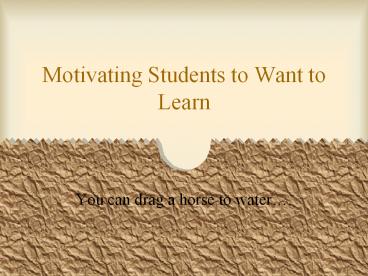Motivating Students to Want to Learn - PowerPoint PPT Presentation
Title:
Motivating Students to Want to Learn
Description:
Motivating Students to Want to Learn You can drag a horse to water . So what about motivation? What is it? How does it manifest itself? What factors affect motivation? – PowerPoint PPT presentation
Number of Views:220
Avg rating:3.0/5.0
Title: Motivating Students to Want to Learn
1
Motivating Students to Want to Learn
- You can drag a horse to water.
2
So what about motivation?
- What is it?
- How does it manifest itself?
- What factors affect motivation?
- Difference between constructive and restrictive
- So how do I motivate??
3
What Is Motivation?
- It is the desire to want to do something it is
CHOICE
4
Some thoughts...
- We make assumptions
- They cant learn
- They dont want to learn
- Theyll never learn
- We make mistakes
- Lack of attention is not lack of motivation
5
Principles of Motivation
- We are motivated differently at different times.
- We are motivated by different factors.
- We are not always motivated.
- Each of us is motivated differently.
6
Factors affecting motivation
- Physical
- Social
- Intake
- Personal
- Past experience
7
Constructive vs. Restrictive
- I want to becauseI enjoy I like
- I like the reward , , privilege, etc
- I like to be accountable, confident, take
initiative
- I have to or else
- Fear or threats that are physical, psychological
- Lack of initiative, blames another, lack of
accountability.
8
Basic Human Motivators
- Personal Gain
- Prestige
- Pleasure
- Security
- Convenience
- Avoidance of punishment
9
Motivators
- Teacher behaviors
- Wait time
- Answers vs. understanding
- Use of
- Declaratives
- Reflective statements
- Invitations to elaborate
- silence
10
Make the benefits of trying more desirable than
the benefits of not trying
- 1. Make sure that assigned tasks are realistic so
that all students can complete them if they
really try. - Small groups
- Different assignments
- Different assessments
- Self-monitoring
11
- 2. Focus students attention on their own
progress, not on others - Base rewards on improvement
- Use individual improvement charts
- Use short-term goals
12
- 3. Reward effort apart from outcome
- Use a separate system of grades or rewards
- Have students reflect on their effort
- Help them learn from their mistakes
- Praise diligence apart from brilliance
13
- 4. Give every student opportunities to
demonstrate competence in class - Set time aside for demonstration in non-academic
areas - Give everyone a job
14
- Allow students to set goals
- Make sure they are realistic and challenging
- Record the goals and track their progress
- Give each student a picture of his/her status
15
REMEMBER MADNESS IS DEFINED AS DOING THINGS SAME
WAY OVER AND OVER AND EXPECTING A DIFFERENT
OUTCOME EACH TIME.































